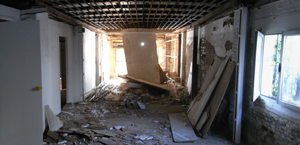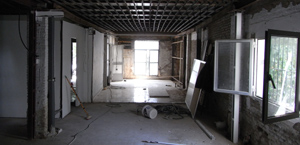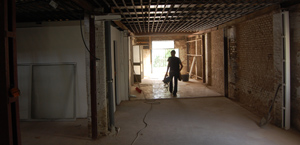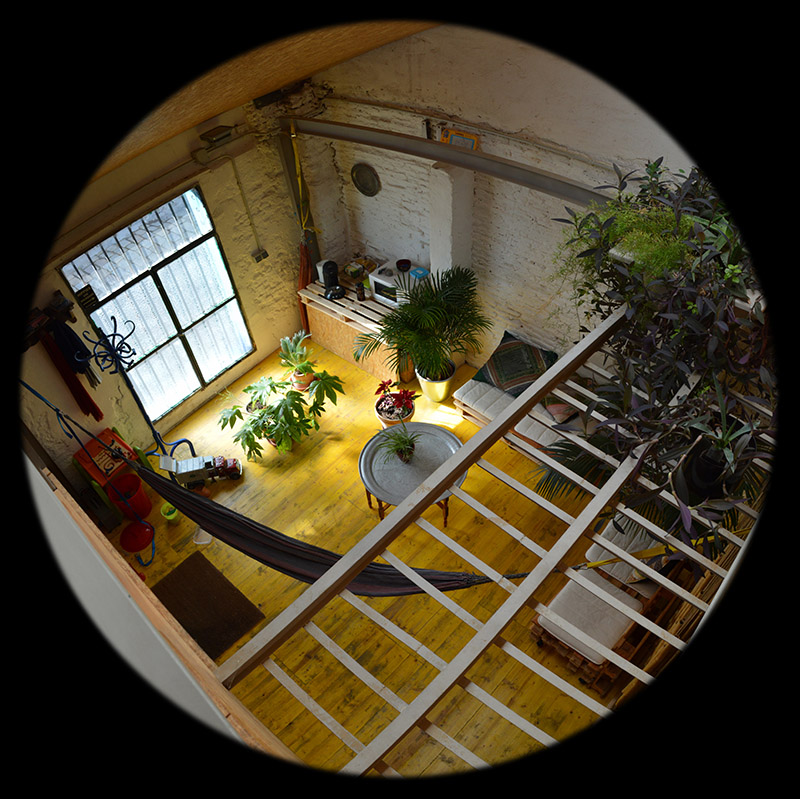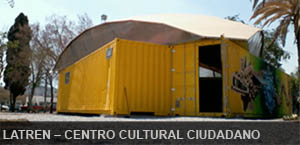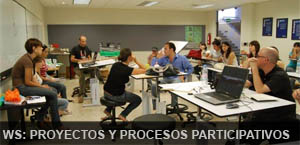>>>>>>>
La Bañera – Shared Space
ATTENTION: THIS PROJECT IS THE RESULT OF A COLLABORATIVE PROCESS BETWEEN CTRL+Z AND DIFFERENT ACTORS. TO UNDERSTAND IT CORRECTLY I INVITE YOU TO KNOW THE OTHER DIRECTLY INVOLVED SUBJECTS: TERRITORIA (SEVILLA).
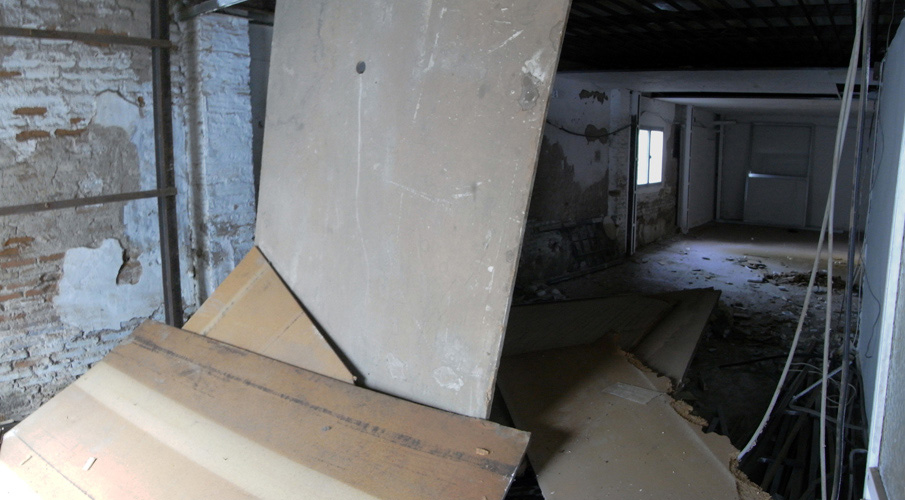 Panorama
Panorama
During the last decades the citizenry had gradually ceased to engage in the construction of their environment, perhaps blinded by the promises of the economic boom. Most of the important aspects of our lives were delegated to public or private institutions and we fully ignore them.
Now following a deep crisis that’s not just economic, but also cultural and social, it’s becoming clear that this confidence was not always justified and that some of the models that flourished in those times were unsustainable and in some cases even carcinogenic.
The crisis has raised awareness of part of the society about the importance of our active involvement in trivial process such as housing and food production or the life of the neighborhoods we inhabit.
These dynamics are increasingly permeating the population redefining values and social balance and leading us to new ways of perceiving and interacting with the city. The tangible result of these changes is the recovery of various participation and associations protocols, being them independent, in collaboration with administrations or lobbying against them.
In this scenario we consider essential to reconfigure also the architectural models as products and especially as work protocols and schemes, through a continuous and experimental research of patterns that can be adapted to the new social conditions that are continuously rearticulating.
 Project’s motivations
Project’s motivations
The shared space “la bañera” project is developed in this scenario and raises from the will of a group of young, and and less young, determined to be actively involved in creating their own living environments, starting with the workplace, and their need to emancipate from some speculative situations in which they were.
The project could serve to create a happy, healthy and vital, work environment while being a good opportunity to reduce fixed costs, share services and create synergies.
Three persons started this adventure with the idea of extending the group infecting others throughout the process. We assessed needs of the physical space and those of the mental one incorporating, from the earliest stages of planning, work  dynamics such as barter and urban recycling.
dynamics such as barter and urban recycling.
Ctrl+Z joined the starting group agreeing on a barter basis, so that, in exchange for its physical or intellectual contribution to the reform, would be entitled to use part of the facilities.
Personally after many years spent in inadequate, unhealthy and that in some cases seemed rather clandestine situations, “offices” I was eager and it seemed to me very interesting to participate in the construction of our own work environment under this scheme, and a good opportunity to apply and value our knowledge about rescue, reuse and use of materials to integrate them into the project.
 Location’s choice
Location’s choice
We started visiting some locations. We were interested in working on the issue of recovery a disused fragment of the industrial or handicraft tissue inside the historic center of Seville, to revitalize and reinstate it to urban life and to its production function through the selfconstruction and with the intention of being an active part of the solution of our own needs.
When we finally choose where to install was clear that space, for its size, it could also serve to provide alternatives to others. We then conceived the idea of a coworking.
The choice fell on local nº5 of the Pelicano’s craftsmen courtyard, located in the popular neighborhood of San Julian, in the historic center of Seville.
The industrial building was composed of an highly fragmented 125m2 ground floor, characterized by a large sliding door that could be closed forming a second front that completely isolate the rear space from the entry lobby.
There was located the access to the 95m2 almost diaphanous upper floor, which wrought, consisting of a simple reconstituted wood board, was in poor conditions due to the numerous leaks present in the deck.
The whole space resulted very dark presenting two ground floor windows, one on the main facade and a smaller one in the south, and another one in very poor condition in the upstairs ceiling. It also suffered various moisture related pathologies aggravated by the abandonment in which had been for years.
Some told us that was not rented over ten years, other than there was a couple who had tried to make it an home, but had resigned after a few months.
Despite all that it seemed to us to have a great potential, both by the characteristics of the existing itself and also for its placement in the urban context and in the cultural and social environment in which it was located.
From the beginning the Pelicano’s artisan community welcomed us with open arms and after a few days were handing out advice, providing tools and shared some meals or beers.
The Project
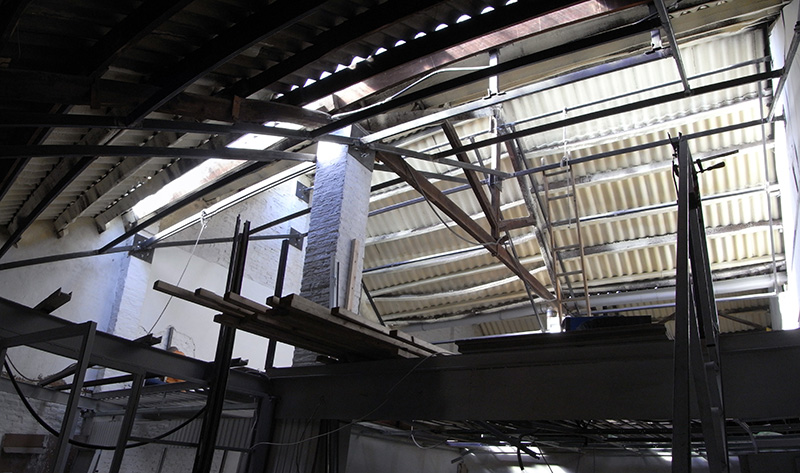 We officially take possession of the premises on October 1, 2011 and during the next six months we were almost entirely dedicated to his conditioning.
We officially take possession of the premises on October 1, 2011 and during the next six months we were almost entirely dedicated to his conditioning.
The first task was the recovery of the original state by removing the results of the various works that had happen and accumulated over time, during this phase we try to separate all the reusable items and proceeded to the recycling of the resulting metal parts.
When removing the ceiling an independent metal structure finished in the bottom with a grid of profiles “T” was discovered. We then find out that in the ’90 the building was used as as warehouse of an import luxury watches store, which justified the construction of a “cage” to prevent breaks in, the fragmentation and the sliding door to close it all.
This process put somehow in crisis all our convictions. We started to work with a clear idea, reform downstairs quickly, but the building, once released, started to suggest us different ways that could 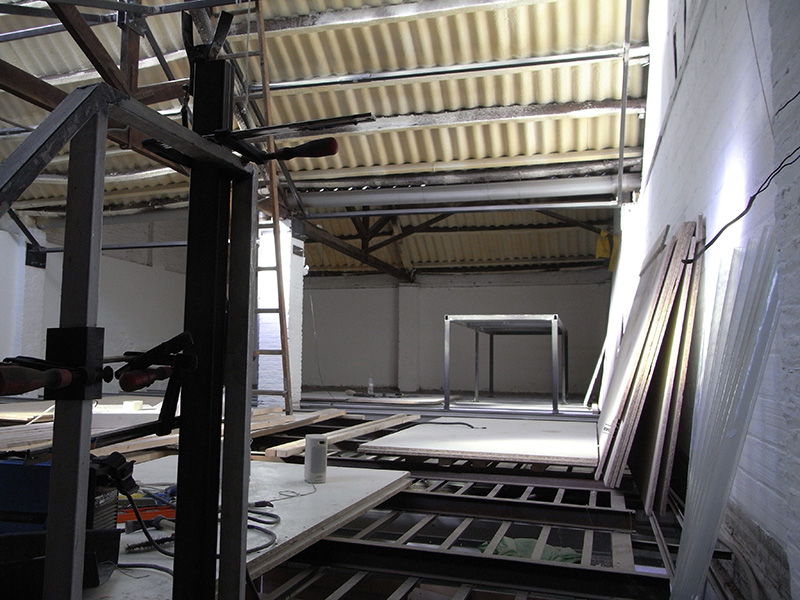 give better answers to the sensations that we were developing slowly while we were getting familiar with its dimensions and proportions.
give better answers to the sensations that we were developing slowly while we were getting familiar with its dimensions and proportions.
Finally, perhaps fascinated by the spaces that were generating upstairs, we decided to develop the reform all at once, spending more time, thus be able to attack and solve all the problems and pathologies at once and avoid the complication of work on them upstairs while the bottom part was in full use.
Spatial concept
After evaluating different options we finally decided for an open plan main room with individual tables in ground floor, to which, respecting the service and the room transformed into a meeting room, only the first portion, which before belonged to the lobby, was subtracted to organize a “chill out” for coffee or informal meetings and also has two hammocks in case a little relaxation is needed. A mosaic of separate but integrated areas to allow their contemporary uses with different activities.
The first floor will be divided into two. The first part will be arranged as a multipurpose room where courses or activities that require a more intimate or simply separate space could take place. In a second stage this part could be equipped with tables if the ground part get fully occupied. The second one will be  used as a warehouse and work area for further reform and improvement, in fact since the opening to complete the different areas several pieces of furniture have been built.
used as a warehouse and work area for further reform and improvement, in fact since the opening to complete the different areas several pieces of furniture have been built.
We raised the interchange option between the two main rooms as needed and following the season, but today we continue with the initial scheme, developing office work on ground floor and other nature activities such as yoga, massage, or hook upstairs.
Our aim was never to seek “density”, the overcrowding, in order to get the most number of workplaces and therefore greater economic benefit, but to create a welcoming environment for people who will spend long hours here every day. An inspiring environment that encourages creativity and where dialogue and interaction can also occur, thus opposed to closed cubicles model that often is applied to coworkings or those of business incubators.
We believed in another concept of a space without segregation, really shared, understood as a physical but also mental, to promote synergies and collaboration among its inhabitants.
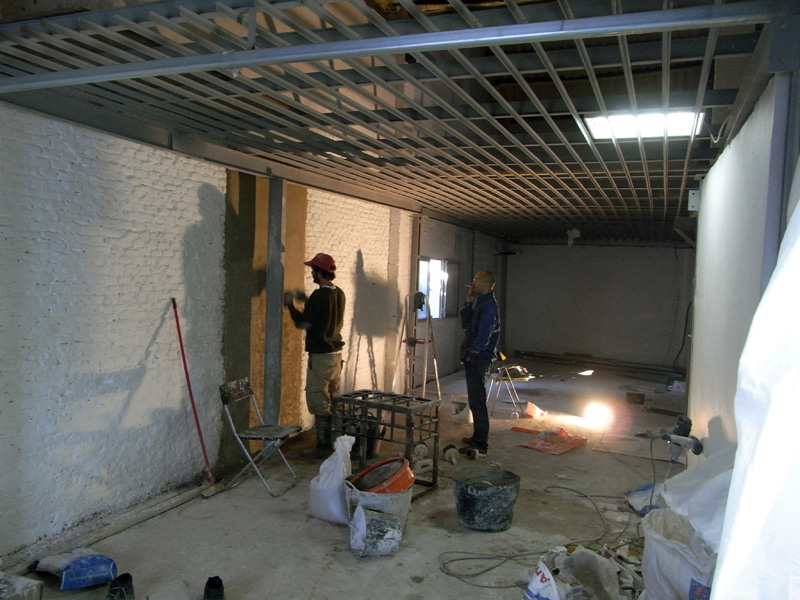 The work
The work
The next step was to recover all those elements that we had decided to keep, we wanted to fully prepare the enclosure before start introducing new elements.
The “T” profiles “grille”, with more than 600 linear meters, took so long, but definitely was worth it because now it is one of the “la bañera”’s most characteristic and attractive elements, and thanks to the color chosen is no longer heavy or oppressive.
Furthermore, its geometry breaks the sound contributing to acoustic comfort.
The bricks were brought to light and the different knockouts were revoked with lime and earth based mortar, minor damage were repaired and everything was topped with lime paint to add light to the environment. In this phase of the work Nacho and Juan appeared, staying until with us the end of the works.
Major leaks were repaired and the window and some ceiling panels were replaced with transparent elements, providing to the factory with a light unthinkable until the moment.
About January we were finishing the top slab solved with a self-constructed sandwich panel that reused parts of the wood profiles salvaged form the disassembly of the original wrought.
profiles salvaged form the disassembly of the original wrought.
From the beginning we perceived clearly the need to bring natural light to the lower level and intend to do so with a skylight that would have been installed in a portion for storage.
At this point of the work everybody was paying much attention to all the elements that could be rescued, and with some luck we find, not very far from us, several crystals probably of a bank, that some gypsies had brought there to sell their framework to a nearby scrap metal dealer, and supported on a structure we tailor build they became our skylight studied to illuminate sufficiently the ground floor.
At the end of January I had to interrupt my physical presence to move temporarily to California for my training in CalEarth, despite I followed the developments and tried as much as possible to make virtual contributions.
“La Bañera” was inaugurated on April 2012 and since then continuous improvements has been produced.

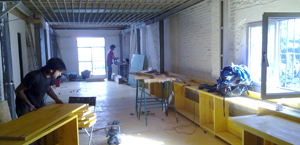
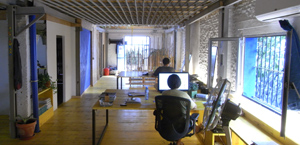
Finishes
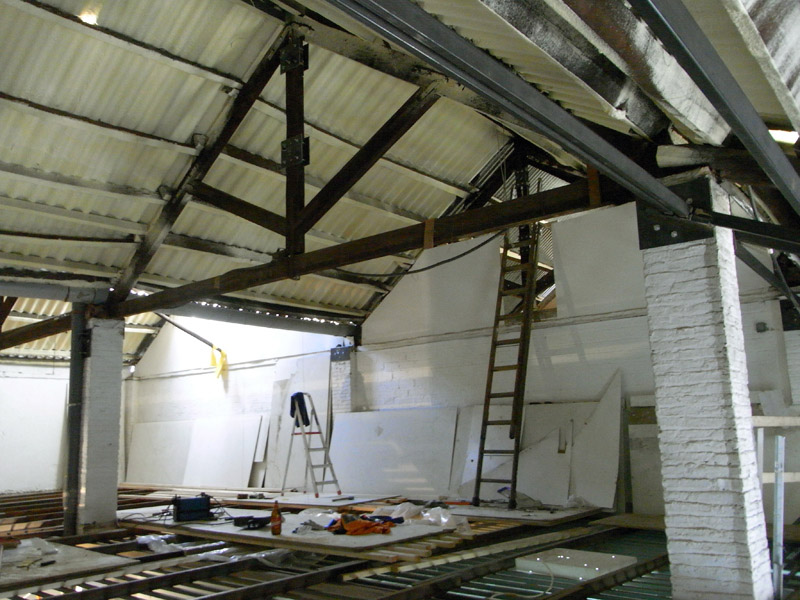 Passive energy saving strategies were incorporated, consider these factors is essential especially in climates like the Seville one.
Passive energy saving strategies were incorporated, consider these factors is essential especially in climates like the Seville one.
The “chimney effect” will really involve the entire volume of air in “la bañera” and it will be able to exit and not build out, the same skylight is adjustable to facilitate this process. The osb false ceiling incorporates generous insulation and includes several air chambers, the last one of 70cm which allows free movement of the hot air to the exterior through adjustable openings prepared in the upper lateral wall (still under construction, lol).
Lighting was also studied thoroughly with the intention that the natural light, despite the spatial configuration, could arrive to most workstations, thus limiting the need for artificial lighting and creating a more pleasant environment.
Marco studied deeply the position of the upper openings to allow light entry throughout the day and different  seasons without this becoming annoying. All skylights are tilted and oriented so to allow light to enter during the winter and prevent it during the summer.
seasons without this becoming annoying. All skylights are tilted and oriented so to allow light to enter during the winter and prevent it during the summer.
Artificial lighting was resolved, after countless discussions and 1:1 scale tests, with “lamp furniture” that bathe the walls and space always with pleasant indirect light. Of course there is the possibility that each one install its custom light spot, but after a year the only one mounted is used rather as rack.
Finally Joso who had also joined the team during the process brought in his experience and passion for the vegetable world installing different planting tubs, which ended up giving name to the coworking, characterizing each with different species, edible or decorative.

These elements along with a weighted choice of materials and finishes endow the whole space of colors and heat. A very distant result from the classic office look.
Joso also introduced the use of the cane, used plenty in entry hall. Harvested in the nearby reeds confers transparency and breathability to the walls and allowed considerable savings since it was initially thought of using polycarbonate, which would have been more expensive, less ecological and would have limited air movement.
Pay attention to urban cycles that produce perfectly usable waste also allowed us to rescue: hydraulic tile for the distribution space, old bricks for the walls, different pallets for furniture and lately 4 new showcase crystals that will soon have use.
Other professionals help was needed for some tasks and where possible we proposed them to include us in their team while they develop a monitoring and advice task. In this way we were able to get formation and limit costs. While others, such as wiring, were commissioned for their complexity to certified technicians.
to include us in their team while they develop a monitoring and advice task. In this way we were able to get formation and limit costs. While others, such as wiring, were commissioned for their complexity to certified technicians.
When the time to build the furniture arrived, everybody involved had been through the training of the overall reform, so that very good results were obtained.
Behind the reeds there is a meeting room, prepared for eight persons, which every morning is the scene of the community breakfast.


Conclusions
Projects like “la bañera” shows that industrial urban tissues are not condemned, but they are an heritage with great potential and give them out would be a severe mistake, irreversible in many cases, and at the same time that simple interventions can give them urban meaning again, returning to these places their production space function.
That despite all with collaboration and joining forces, with less resources and more inventiveness, you can create spaces of opportunity.
Finally form a small group we got solved our needs and we have now a comfortable working space in the historic center of Seville which is made available to others at a reasonable price.
For its activation large investments or infrastructure were not required, but rather the commitment of the people involved.
The project became a research for a virtuous balance between new, natural and reused materials, between ideas and their lowtech application, to act in a 100% reversible way.
The result was “la bañera”, a shared space continually evolving that reinvents itself every once in a while to adapt to the new demands of its inhabitants.

You can find the latest news about the shared space on the website of “la bañera”.
Those interested in sharing can write to labanhera@gmail.com or call 955312839 / 699891631










